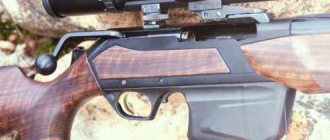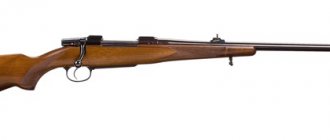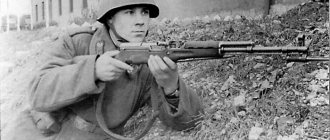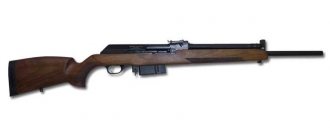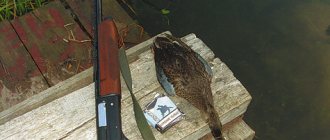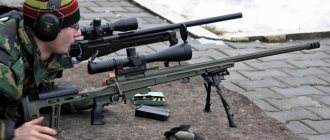In order to increase the accuracy and firing range of modern carbines, special devices and accessories are provided, thanks to which the firearm is endowed with the necessary technical parameters and an attractive external design. Today, the Izhevsk manufacturer presents to the attention of fans of firearms shooting an improved and modified Tokarev self-loading rifle, better known as the KO-44 hunting carbine.
What is a weapon?
The KO-44 carbine is a military carbine, manufactured in 1944, not equipped with a bayonet. It was based on the three-line Mosin rifle and KO-38.
The model has a modern design and good aesthetic properties. Frequent shooting and operation in field conditions became possible thanks to the application of special compounds to the most susceptible areas of the hull. You can increase the shooting efficiency by using additional equipment: a flash suppressor and an optical sight installed on the KO-44 carbine. The price and advanced capabilities of this model explain the increased interest in it among both professional hunters and sports shooting enthusiasts.
History of the rifle
Despite the fact that the year of production of the legendary three-line is 1891, its mass use began only in 1892. During this time, the carbine underwent intensive modernization associated with the elimination of existing shortcomings. As a prototype, designer Sergei Ivanovich Mosin decided to use his earlier work, borrowing the bolt group and receiver from it. However, in order for the carbine to be adopted by the Russian army, the bolt had to be changed, as well as the magazine, which was done.
In 1892, at the Izhevsk, Sestroretsk and Tula arms factories, mass production of a new carbine began with the goal of equipping the entire army with it. However, even the three largest manufacturers were not enough to cope with the volume of work, so the government was forced to ask for help from the French and their arms company in the city of Chatellerault. Thus, “Mosinka” gained fame not only in Russia, but also in European countries. During the First World War, it was quite common to see a French soldier with a three-ruler.
The Russian army also repeatedly tested the Mosin rifle in the field. The first “contact” of the three-line with the enemy occurred during the battle with the Afghans in the Pamirs (1893). The Mosin rifle has proven itself to be a reliable, accurate and quite powerful weapon, capable of successfully mowing down soldiers and commanders from the enemy ranks. After this, many European countries became interested in the model, and already in 1897 the carbine was in service in 10 of them. However, the success of the Mosin rifle abroad ended during the First World War, as there was an intensified arms race at the beginning of the 20th century. Even then, the three-line was inferior to many analogues of European weapons.
Russia began to think about removing the Mosin rifle from service only during the reign of Soviet power. However, with the advent of a magazine modification in 1938, designed for shooting up to 1000 meters, the three-ruler gun again found itself in the hands of a Russian soldier. The new Mosinka showed good results during the Great Patriotic War, so it was not taken out of production for a long time. The Soviet army decided to abandon the legendary carbine gradually, introducing the Kalashnikov assault rifle as a replacement, as well as the SKS carbine. However, in many countries of Eastern Europe the rifle was in service until the early 90s.
How does the model work?
The KO-44 carbine, thanks to its simple design, is convenient and easy to use. The main connoisseurs of this feature of the weapon were novice shooters.
The KO-44 carbine consists of the following elements:
- Barrel with butt. They are the main structural parts. Birch wood is used to make the stock.
- Store. Wanting to increase speed and convenience when shooting, the owner of a hunting carbine can replace the basic magazine that is included in the kit with a magazine with a larger capacity.
- Shutter. Used to send ammunition into the chamber. The combat bolt contains a bolt stem, a combat cylinder, an ejector, a hammer, a firing pin, a mainspring and a connecting bar.
- Rubberized butt plate, which is equipped with the butt. Due to the high level of depreciation during shooting, the carbine has become much more comfortable.
- Special stops (two pieces) that completely lock the barrel and ensure safe operation of the hunting rifle.
Design
The three-line design represents simplicity and reliability. Even though the weapon was created more than a century ago, it can still compete with many modern carbines and sniper rifles. You can see the drawings and dimensions of the weapon in the photographs below.
Trunk
The barrel of the Mosin carbine has 4 grooves along the entire length of the bore. In early versions they were trapezoidal in shape, while in later versions they were rectangular. The barrel diameter is 7.62 mm, which is 3 Russian lines (which is why it is called a three-line).
At the rear of the barrel channel there is a chamber, as well as a threaded stump to which the receiver is attached. Above the chamber you can find a factory mark, which can be used to easily determine the manufacturer of the weapon and the year of its manufacture.
Magazine box and reflector cut-off
The Mosin rifle, without modifications, holds 4 cartridges, which are arranged in a row. Their edges are made in such a way as not to interfere with the supply of new ammunition into the barrel. By modern standards, the store has a rather unusual shape. However, during the Tsarist Empire, this version was used in almost all rifled rifles.
One of the main features of the Mosinki magazine is that it has a special cut-off reflector designed to separate the cartridge from the barrel channel. Thanks to this particular part, the new cartridge is caught at the moment when the old one is released. Reflectors also serve to protect ammunition from hitting each other.
The cut-off reflector is the invention of the Russian designer Mosin
The cut-off is the personal invention of the designer Mosin, and it is to it that the rifle owes its reliability. However, it should be noted that such a part was tailored for the use of old ammunition. If the Mosin rifle is adapted for new cartridges, then there is simply no point in the reflector, since their cartridges do not have a special rim (welt).
Trigger
The design of the trigger mechanism of the three-ruler is quite simple, so even an inexperienced gunsmith can handle disassembling the trigger. Here are the main parts that make up this part:
- trigger or “petal”;
- trigger spring (plays the role of a sear);
- trigger pin;
- fixing screw;
- pins and couplings.
The trigger of the carbine is quite long and tight without the “warning” characteristic of rifles - the stroke of the hook is not divided into two parts, requiring different forces from the shooter to press. The ability to adjust the trigger stroke is present only in modified versions.
Gate
The bolt mechanism of the Mosin rifle is classic, longitudinally sliding. Its device consists of the following parts:
- bolt stem with handle and comb;
- mainspring (cylindrical or twisted);
- combat larva (what the shooter holds on to);
- cartridge ejector (not to be confused with extractor);
- connecting strip;
- striker or striker;
- trigger (external).
As soon as the bolt is unlocked, the mainspring is compressed and the rifle's firing position is activated. When locked, the firing pin rests against the sear (trigger spring). The weapon goes on safety only at the moment when the shooter pulls the trigger to the rear position, moving it counterclockwise.
Stock and barrel lining
To make the butt and stock for the Mosin rifle, birch or hazel is usually used. In this case, the parts are integral and do not separate from each other. The neck of the stock has a convenient straight shape, which is especially useful when using the weapon in close combat (a bayonet-knife was often attached to the carbine).
In many versions of Mosin rifles, the barrel in the upper part is covered with a wooden barrel lining, which provides the metal part with additional safety and also prevents the possibility of the shooter getting burns. The wooden parts are attached to the rifle using two stock rings and two screws.
Sights
Initially, the three-ruler was equipped only with an open sighting device, consisting of a rear sight and a front sight. Later, the rifle acquired a stepped sight, designed for shooting at distances of 400, 600, 800, 1000 and 1200 meters. The shooter could simply set the rear sight bar in the desired position and shoot accurately.
Since 1932, the Mosin carbine began to be supplied with an installed PU, PB or PE optical sight. Such devices provided a 3- or 5-fold magnification of the image, and also had good accuracy. After the Second World War, not only military models of the Mosinka, but also civilian counterparts began to be equipped with sniper scopes.
Bayonet
It is difficult to imagine a Mosin rifle of the 1893 model without a special bayonet designed to defeat the enemy in close combat. Now versions of the carbine are produced without it, since there is no longer any need to engage in hand-to-hand combat with someone. Previously, the bayonet was an inseparable part of the Mosinka and had to be on the weapon at all times, including on the march. Well, so that the sharp tip did not interfere with the soldier too much, it was tucked inside the receiver - this position was acceptable only when transporting soldiers by road or rail.
Accessories
The three-line series has a fairly extensive set, which contains everything necessary to maintain the “health” of the weapon in perfect condition. Here is the basic set of accessories that was included in the set:
- oiler with two compartments (for oil and alkaline solution);
- muzzle pad (intended for cleaning the barrel;
- ramrod coupling;
- bristle brush;
- gun belt;
- hairpin;
- screwdriver;
- rubbing.
The Russian soldier always followed the principle: if you do not take care of your weapon properly, then you will not live long. Therefore, there is nothing surprising in such a large number of accessories - everything was made for people.
Operating principle
Firing is carried out after pressing the trigger engaged with the bolt. As a result, a shot occurs from the strong impact of the unfolding spring on the firing pin. The place where the ammunition is contained is an integral box magazine. To reload, simply turn and move the sliding bolt manually. At the same time, the barrel channel is unlocked, and the trigger mechanism is cocked.
The KO-44 carbine produces slight recoil to the shoulder when firing. The trigger mechanism of this weapon is equipped with a convenient push-button safety, allowing the hunter to fire single shots. You can also cock the hammer mechanism or put it on safety manually, without opening the bolt.
Performance characteristics
- Country of origin: Russia.
- The carbine is produced at the machine-building plant.
- Intended for hunting and sport shooting.
- KO-44 belongs to the self-loading automatic carbines.
- The magazine holds 4 rounds.
- The length of the entire weapon is 1 m 12 cm.
- Barrel length – 625 mm.
- Height 200 mm.
- Weapon width 60 mm.
- The carbine weighs no more than five kilograms.
- In the manufacture of the barrel, cold forging technology is used, with further application of an epoxy coating to the product.
Ammunition for weapons
Depending on the scope of application of the carbine, two types of cartridges are provided for it:
- 7.62x39. Ammunition of this caliber contains semi-jacketed bullets. For hunting medium and large-sized animals, the KO-44 is equipped with these cartridges.
- 62x54. The carbine (price ranges from 7-8 thousand rubles) is used for standard shooting. Ammunition of this caliber is equipped with jacketed bullets, which have a fairly high initial velocity. They are capable of hitting a target at a distance of up to 200 meters.
Hunting modifications
Over the years of production of the three-line rifle, many modifications of this weapon have been released. Engineers tried to take into account the requirements of their customers and produce new varieties exactly as their customers wanted to see. As a result, today we can distinguish 6 popular modifications that will appeal to certain groups of people.
Carbine KO-91/30
Civilian version of the Mosin rifle, released in 1944. Designed exclusively for hunting medium and large animals. The mechanical safety was replaced with an automatic one, which increased the safety indicator when using the weapon. The modification can be equipped with either a conventional open sight or an optical version. The technical characteristics of the weapon are as follows:
| Weapon caliber | 7.62 mm |
| Ammunition used | 7.62x54R |
| Overall carabiner length | 1232 mm |
| Barrel length | 745 mm |
| Maximum bullet speed | 860 m/s |
| Sighting range (open sight) | 300 m |
| Spacious store | 5 rounds |
| Carabiner weight | 4 kg |
Carbine KO-38
In fact, this is an army modification of the 1938 Mosin carbine. However, hunters often used it for their own purposes, especially after the model was removed from service. An adjustable bar is used as an aiming device, which can be adjusted to different distances. The carabiner is lighter in weight and smaller in size. The technical characteristics presented in the weapons passport are as follows:
| Weapon caliber | 7.62 mm |
| Ammunition used | 7.62x54R |
| Overall carabiner length | 1020 mm |
| Barrel length | 512 mm |
| Maximum bullet speed | 890 m/s |
| Sighting range (open sight) | 1000 m |
| Spacious store | 5 rounds |
| Carabiner weight | 3.5 kg |
Carbine KO-44
American modification of the Mosin rifle, released in 1944. The weapon was significantly reduced in size and was equipped with an adjustable rear sight instead of the standard rear sight. In general, the rifle is very similar to the previous version, if you do not pay attention to the increased weight (a consequence of the fact that the manufacturer used more durable wood). Performance characteristics in comparison with KO-38 have remained almost unchanged:
| Weapon caliber | 7.62 mm |
| Ammunition used | 7.62x54R |
| Overall carabiner length | 1020 mm |
| Barrel length | 517 mm |
| Maximum bullet speed | 880 m/s |
| Sighting range (open sight) | 1000 m |
| Spacious store | 5 rounds |
| Carabiner weight | 3.9 kg |
Carbine KO-8.2
In appearance and design, this is still the same Mosin rifle. But for shooting it uses 8.2 mm ammunition, which is intended for hunting large animals. Despite the rather large cartridge, the model still has a fairly high muzzle velocity. The rifle is also lightweight, which is especially important for fishing enthusiasts:
| Weapon caliber | 8.2 mm |
| Ammunition used | 8.2×66 mm |
| Overall carabiner length | 1010 mm |
| Barrel length | 520 mm |
| Maximum bullet speed | 520 m/s |
| Sighting range (open sight) | 300 m |
| Spacious store | 5 rounds |
| Carabiner weight | 3.6 kg |
Receivers of the carbine KO-8.2
Carbine OTs-48
One of the most modern modifications of the Mosin rifle, sharpened for firing with 7.62x54R cartridges. However, do not rush to think that it is no different from the 1892 model. In this version, the stock and bolt were replaced with modern ones, designed for offhand shooting. Thanks to this, the weapon not only became more ergonomic, but also began to have much greater combat characteristics:
| Weapon caliber | 7.62 mm |
| Ammunition used | 7.62x54R |
| Overall carabiner length | 1080 mm |
| Barrel length | 560 mm |
| Maximum bullet speed | 890 m/s |
| Sighting range (optics) | 1500 m |
| Spacious store | 5 rounds |
| Carabiner weight | 3.7 kg |
Carbine "Los-7-1"
A modification of the Elk carbine, famous in hunting circles, which was developed back in Soviet times. The main distinguishing feature is that more modern 7.62×51 cartridges are used for shooting, which have better accuracy and greater penetrating power. This is exactly the kind of ammunition that can be found in most Saiga or Tiger rifled hunting carbines. The performance characteristics of the weapons are really impressive:
| Weapon caliber | 7.62 mm |
| Ammunition used | 7,62×51 |
| Overall carabiner length | 1040 mm |
| Barrel length | 550 mm |
| Maximum bullet speed | 920 m/s |
| Sighting range (open sight) | 1800 m |
| Spacious store | 5 rounds |
| Carabiner weight | 3.5 kg |
Among carbine connoisseurs, opinions differ regarding the Mosin rifle as a weapon for hunting. Some believe that it is simply outdated, because many modern analogues actually surpass the three-line in terms of characteristics. Others are confident that the model is worth buying, if only because of its simple design and high reliability. Which side to choose in this debate is not always clear. However, only one thing is clear: “Mosinka” is a legendary rifle that deserves respect and attention to its person.
Weapon Strengths
The advantages of KO-44 include:
- Comfort during use. Due to the ergonomically shaped body, the carabiner is convenient to use for both men and women. The weapon fits equally comfortably in the shooter's hand, regardless of its size.
- Due to the use of natural wood, the carabiner has a high aesthetic design.
- The weapon, thanks to two types of ammunition, has expanded capabilities.
- The carbine can be used in the most adverse conditions. It is not afraid of either high humidity or temperature changes inherent in field conditions. This unpretentiousness is ensured by the presence of a high-quality steel barrel, which is equipped with the KO-44 carbine.
Weapon reviews
According to the owners of these carbines, the product has a good rate of fire and accuracy. KO-44 is effective both for hunting and during training or sports shooting. Reviews from most owners about this model of hunting weapon are predominantly positive.
Some hunters note that with frequent use of the carbine, soot and dirt often accumulate in its barrel, which in the future can lead to the onset of corrosion processes. To prevent this, experienced hunters recommend paying increased attention to the condition of the weapon: cleaning the barrel passages as often as possible, using an alkaline composition and a special cleaning rod. Be sure to wipe the barrel dry every time after such cleaning. The ability to perform tuning in the carbine is another property of the weapon, which is especially appreciated by fans of aimed shooting at long distances.
Thanks to tuning, the KO-44 can be equipped with optical sights produced by various manufacturers. This function also applies to carbine box magazines. If desired, it can be replaced with a more spacious one.
Prices for carbines, according to owners, are relatively low. By spending around seven thousand rubles, you can purchase excellent small arms with high technical parameters.
Advantages and disadvantages
Due to the fact that the Mosin rifle has a huge number of advantages, it is still popular among hunting enthusiasts. Here are just the points that are mentioned most often:
- High cartridge power. You can compare it with .30-06 caliber ammunition. Thanks to this, the weapon is ideal for hunting elk, boar, wolf and even an adult bear. The likelihood of leaving wounded wounds behind is extremely low, especially if you shoot at vulnerable parts of the body.
- Good combat accuracy and accuracy. It was not for nothing that Soviet soldiers armed their snipers with Mosin rifles. The weapon is capable of hitting the target accurately even from a distance of 1.5 kilometers. The spread of bullets at a distance of 100 meters is no more than 2 cm, which is incredibly small even for a rifled weapon.
- Huge resource of the barrel and bolt frame. Russian weapons were produced conscientiously and for the people. This means that the carbine, which was purchased back in the century before last, can also be successfully used by representatives of the modern generation of hunters. The most important thing is not to neglect the rules of care.
- Reliability of mechanisms. The Mosin carbine can be used in any climatic conditions. These are not empty statements from the manufacturer, but a well-founded fact. During World War II, Soviet snipers could successfully shoot enemy officers even in bitterly cold conditions (about -50 degrees Celsius).
- Reliable and simple design. It is difficult to find another rifle that is as uncomplicated. Complete disassembly of the rifle is not difficult even for an inexperienced hunter. And the likelihood that the trigger springs will stretch or the firing pin will fail remains extremely negligible.
- Quite a high rate of fire. Not all modern guns are capable of firing at a speed of 1 round per second. At the same time, reloading the carbine will also not require much time. This indicator will be useful both for hunting enthusiasts and for those who prefer training shooting.
Do not forget that the Mosin rifle was released more than a century ago. This fact could not but affect the number of negative aspects. Here is a brief description of the points that you should think about before purchasing:
- an outdated cartridge with a rim - there are analogues with better technical characteristics;
- quite sensitive cut-off reflector - may fail from time to time;
- horizontal arrangement of the bolt cylinder and stops - the accuracy of the fire suffers;
- a long and difficult descent, without a “warning” - it will be quite difficult to get used to;
- the long bayonet on the original versions - in modern conditions it is of no use;
- inconvenient bolt handle - it simply interferes with quick reloading of the cartridge;
- the fuse is inconvenient to use - you have to activate it yourself;
- lack of choice of ammunition designed for hunting - after all, 7.62x54R is a military cartridge;
Mosin rifle with 7.62x54R cartridges
- the difficulty of installing good optics - the rifle was not originally designed for this;
- the need to adjust the bracket to a modern sight - extra tuning costs;
- the straight neck of the butt is not convenient for shooting offhand - it is designed for bayonet fighting;
- The stock wood is of low quality - cracks appear over time.
There are many disadvantages. But still, this is a Mosin rifle - a legendary weapon that took part in two world wars and countless armed conflicts. Is it really impossible to forgive a carbine for the fact that it is slightly outdated?
